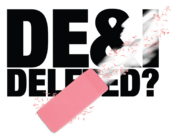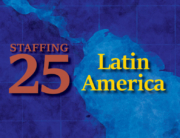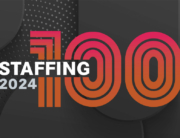In an ongoing series, Staffing Industry Review features excerpts from a 2019 Executive Forum session based on SIA President Barry Asin’s and Charted Path founder Mike Cleland’s book, Breaking Through: Leadership Disciplines from Top-Performing Staffing Firms, which captured the stories of staffing industry executives whose companies have reached the top-most 1% of US staffing firms. In our May/June issue, the authors shared the underlying concepts that became the basis of their book. Three executives featured in the book participated in the Forum presentation. We share their case studies through the rest of 2019. The first is that of ettain group, presented by co-founder and Chairman Jeffrey Harris.
Jeffrey Harris. I like to tell people [this is] really a case of some controlled paranoia, on my part, of never really feeling like we were going to be successful. And really, it’s a case of being very, very humble and willing to learn.
We started ettain group in 1996 out of a bedroom in a house in Charlotte, North Carolina, where we are headquartered today.
I’ve spent a lot of time throughout my career being part of a lot of organizations, networking organizations, groups I can learn from — one being on the board of the American Staffing Association for the last two years. We formed the National Staffing Alliance. Jeff Bowling [whose case study will be featured in the September/October issue of Staffing Industry Review] was part of that peer networking group, where we shared a lot of best practices and our own case studies and tried to challenge each other to grow and hold each other accountable.
And then I’m part of another group, the IT Staffing Executive Roundtable, which has executives from seven or eight IT staffing companies that are $100 million, $200 million in size. So, and I would say this is a common theme, I’m a product of many really smart people that I was fortunate to surround myself with through my career.
I actually never had an interest in staffing coming out of college and I’m sure many of you felt that way. I didn’t even know what it was. I had a bachelor’s degree in biology and I was on my way to medical school when my father, who was a doctor, said, “You might want to just go get a job for a year … this [medical] industry is getting a little messed up. Just go try it out before you go down that road.” So I did that, and actually started my career with Allegis Group in 1993. And basically, it’s gone up from there.
I fell in love with the industry. I realized that I should be in business and not in a hospital. …
So, who are we? Ettain group is a talent solution company. We have really two primary services: One is recruitment services, providing IT staffing, healthcare IT staffing and creative digital staffing. We also have a managed services and project services division that is a very rapidly growing piece of our business and something that we are continuing to see a ton of demand for. And that’s probably right now outpacing our transactional IT staffing business.
We finished 2018 at $175 million in revenue and are now running at about $200 million in revenue. I’ll show you a little bit about what we’ve been up to in order to get there.
Building a legacy. We won the Best of Staffing Talent and Client Diamond awards eight years in a row and I would say — and this is going to be a common theme — we built an organization really on our culture. A culture where we stick to the values that we created as a team very early on and a vision that is a self-sacrifice type of culture.
We tell everyone who comes to work for us that your job is really to help make the person next to you successful. And if you do that, you will be successful. That is a very common theme. It’s something that is important to us as we promote people. The criteria for that is it’s not about how many dollars you produced; it’s about building your legacy. How many people have you influenced? What’s the respect level that you have among your peers? What are they saying about you — not necessarily your boss.
And we constantly remind all of our staff where we came from. The partners and the owners have really had to do every single job [within the company], so the staff can appreciate that. We have a lot of fun, we do Pictionary, we’ve had a golf tournament. Our team decides to dress up as Star Wars characters. We bring merchants into the office on a regular basis to offer discounts for stuff for our staff to be able to buy. The top one there is our big cancer charity. We hold a poker tournament in Charlotte every year to support cancer and then we recently actually started supporting the Whole Vet (program). It provides assistance to veterans. The values we focus on are attitude, performance, accountability, respect and team work.
And the one thing that I say continually to our folks is, “We did not create this business because we were trying to create a great staffing business. We created the company just to be a great company.” So we see the things that have helped us be successful. I tell our people we could probably go open up a peanut company tomorrow with most of the same people and most of the same disciplines and cultures and values that we have today and we would be successful.
First decade. We spent about our first 10 years or so as a lifestyle business. It took us until about 2006 to grow our business to $30 million. We sort of hit a plateau at that point. We did the same thing at $10 million. I still remember talking to my business partner when we were a $3 million business, saying, “How are we possibly going to get to 10?” I had no idea how we were going to do this. We were always profitable; we operated mostly at the midmarket, we had a few offices.
Committing to Growth
And 10 years into the business we said, “What are we going to do?” Were we going to keep growing slowly or stay flat and have a nice $30 million business or were we going to grow this thing? We decided we really wanted to grow this thing. And then we had to decide how we would do that.
Then, we did a few things. We were coming out of the recession in 2007. We rallied our whole team, saying when we come out of this thing, the industry is going to boom. We were very, very positive with our team that this was a good thing, this is going to help us when we come out, and we’ve got to be ready.
We started to embrace big national accounts. We had been doing more midmarket, smaller accounts. We really learned to say no and what customers we weren’t going to do business with, more than what customers we were going to do business with. We decided to grow very deep in the geographies we were already in, rather than trying to create offices all over the place, which is extremely difficult to do.
And we said, “We can do more with what we already have.” Our headquarters was in Charlotte. We had five other branches, but we said we absolutely have to be the best company in our backyard, and we went on a mission to do that. We got very intentional with the customers we were going to go after. If we put a number out there, we were going to hit it. And that was a lot of fun. We were all reading [Jim Collins’] Good to Great book, and we really did execute on that.
People strategy. There are people who had been with us for a long time, right up through that time period, and we had to make some tough decisions. We had to ask them to either do a different job — one that was probably not as senior as they would have liked — or leave. That was a pivotal moment for me to make that decision regarding people who had been loyal to our business for a long time. But we realized that what got us here would not get us there — and that included myself.
I knew at that time that I had to keep learning, and was always questioning whether I was the guy who could be the CEO of a $200 million business. I didn’t know I had chops. I was willing to tell my team, “I’m in the same boat as you guys and if I get to the point where I don’t think I’m qualified to do this, then I will get somebody else.” We also put together a very intentional hiring and training strategy for external talent to come in.
Saying no. And we made profitability really, really important. In this industry, we talk a lot about sales and revenue and top line, and when I would get together with some of my peers who would say, “You know I’d rather own a $50 million business that makes 10%, 15% margins than a $100 million business that makes 3% margins.” And we became very intentional in what customers we would deal with, and which customers we wouldn’t.
It created a lot confidence with our team; it created some swagger that they could go out and tell a customer no. That is so hard to do in our business. Those were the big pieces.
Reaping the Rewards
It took us about 24 months to really get through that process, and we went from $30 million to $100 million in about three years, after spending the first 10 or 12 really kind of flat. So it was a pretty awesome experience.
Then in 2014 we ended up doing a majority recap with a private equity firm, which has been a fantastic experience for us. They really helped us get into this execution phase and continue to grow the business. And now we’re on a fantastic trajectory and I actually hired my replacement who started in September 2018; I’m now the chairman and just having a lot of fun.
Want to find out how your firm can break through? Visit www.staffingindustry.com/breaking-through







